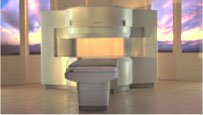 | Info
Sheets |
| | | | | | | | | | | | | | | | | | | | | | | | |
 | Out-
side |
| | | | |
|
| | | | |
Result : Searchterm 'Phased Array Coil' found in 1 term [ ] and 8 definitions [ ] and 8 definitions [ ], (+ 15 Boolean[ ], (+ 15 Boolean[ ] results ] results
| 1 - 5 (of 24) nextResult Pages :  [1] [1]  [2] [2]  [3 4 5] [3 4 5] |  | |  | Searchterm 'Phased Array Coil' was also found in the following services: | | | | |
|  |  |
| Phased Array Coil |   |
| |
|
| |  | | | | • Share the entry 'Phased Array Coil':    | | | | | | | | | |  Further Reading: Further Reading: | Basics:
|
|
| |
|  | |  |  |  |
| |
|

From Hitachi Medical Systems America Inc.;
the AIRIS II, an entry in the diagnostic category of open MR systems, was designed by Hitachi
Medical Systems America Inc. (Twinsburg, OH, USA) and Hitachi Medical Corp. (Tokyo) and is manufactured by the Tokyo branch. A 0.3 T field-strength magnet and phased array coils deliver high image quality without the need for a tunnel-type high-field system, thereby significantly improving patient comfort not only for claustrophobic patients.
Device Information and Specification
CLINICAL APPLICATION
Whole body
QD Head, MA Head and Neck, QD C-Spine, MA or QD Shoulder, MA CTL Spine, QD Knee, Neck, QD TMJ, QD Breast, QD Flex Body (4 sizes), Small and Large Extrem., QD Wrist, MA Foot and Ankle (WIP), PVA (WIP)
SE, GE, GR, IR, FIR, STIR, FSE, ss-FSE, FLAIR, EPI -DWI, SE-EPI, ms - EPI, SSP, MTC, SARGE, RSSG, TRSG, MRCP, Angiography: CE, 2D/3D TOF
IMAGING MODES
Single, multislice, volume study
TR
SE: 30 - 10,000msec GE: 20 - 10,000msec IR: 50 - 16,700msec FSE: 200 - 16,7000msec
TE
SE : 10 - 250msec IR: 10 -250msec GE: 5 - 50 msec FSE: 15 - 2,000
0.05 sec/image (256 x 256)
2D: 2 - 100 mm; 3D: 0.5 - 5 mm
Level Range: -2,000 to +4,000
POWER REQUIREMENTS
208/220/240 V, single phase
COOLING SYSTEM TYPE
Air-cooled
2.0 m lateral, 2.5 m vert./long
| |  | |
• View the DATABASE results for 'AIRIS II™' (2).
| | | | |
|  | |  |  |  |
| |
|

Developed by GE Lunar; the ARTOSCAN™-M is designed specifically for in-office musculoskeletal imaging. ARTOSCAN-M's compact, modular design allows placing within a clinical environment, bringing MRI to the patient. Patients remain outside the magnet at all times during the examinations, enabling constant patient-technologist contact. ARTOSCAN-M requires no special RF room, magnetic shielding, special power supply or air conditioning.
The C-SCAN™ (also known as Artoscan C) is developed from the ARTOSCAN™ - M, with a new computer platform.
Device Information and Specification
CLINICAL APPLICATION
Dedicated extremity
SE, GE, IR, STIR, FSE, 3D CE, GE-STIR, 3D GE, ME, TME, HSE
SLICE THICKNESS
2D: 2 mm - 10 mm;
3D: 0.6 mm - 10 mm
4,096 gray lvls, 256 lvls in 3D
POWER REQUIREMENTS
100/110/200/220/230/240V
| |  | |
• View the DATABASE results for 'ARTOSCAN™ - M' (3).
| | | | |
|  |  | Searchterm 'Phased Array Coil' was also found in the following services: | | | | |
|  |  |
| |
|
An array coil combines the advantages of smaller coils (high SNR) with those of larger coils (large measurement field).
This type of RF coil is composed of separate multiple smaller coils, which can be used individually ( switchable coil) or combined.
When used simultaneously, the elements can either be:
•
coupled array coils - electrically coupled to each other through common transmission lines or mutual inductance
•
isolated array coils - electrically isolated from each other with separate transmission lines and receivers and minimum effective
mutual inductance, and with the signals from each transmission line processed independently or at different frequencies
•
phased array coils - multiple small coils arranged to efficiently cover a specific anatomic region and obtain high-resolution, high-SNR images of a larger volume. The data from the individual coils is integrated by special software to produce the high-resolution images.
See also the related poll result: ' 3rd party coils are better than the original manufacturer coils'
| | | |  | |
• View the DATABASE results for 'Array Coil' (22).
| | |
• View the NEWS results for 'Array Coil' (1).
| | | | |  Further Reading: Further Reading: | News & More:
|
|
| |
|  | |  |  |  |
| |
|
| |  | |
• View the DATABASE results for 'Coil Diameter' (3).
| | | | |
|  | |  |  |
|  | |
|  | 1 - 5 (of 24) nextResult Pages :  [1] [1]  [2] [2]  [3 4 5] [3 4 5] |
| |
|
| |
 | Look
Ups |
| |